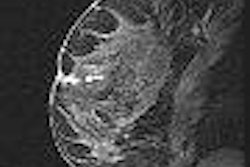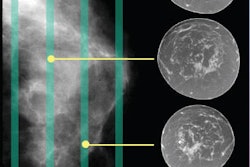Finally, some good news for breast imagers -- breast cancer screening with mammography does offer a significant survival benefit in comparison to other cancer detection methods, according to an August 17 report in the Journal of the National Cancer Institute. In addition, this benefit exists in spite of two types of bias -- lead time and length -- that can skew detection data.
"In this article, we quantified the residual lead-time bias and length bias beyond stage shift that is associated with breast cancer screening, and this is still present after adjusting stage of disease," wrote Donald Berry, Ph.D., and colleagues. Stage shift is the phenomenon whereby tumors detected at screening tend to be at an earlier stage of development. However, earlier detection may not necessarily lead to longer survival.
"We found that method of detection is an important prognostic factor for breast cancer survival, even after adjusting for known tumor characteristics," they added (JNCI, August 17, 2005, Vol. 97:16, pp. 1-9).
Berry and three of his co-authors are from the department of biostatistics and applied mathematics at the M. D. Anderson Cancer Center in Houston. Other contributors are from the University of Seattle in Washington and the University of Toronto in Ontario.
The group mined data from the first five years of three randomized screening trials: the Health Insurance Plan of New York trial (HIP) and two Canadian National Breast Screening Studies (CNBSS 1 and CNBSS 2). Interval and incidence breast cancers were combined in their analyses.
Berry's group found a clear shift toward earlier stage in screen-detected cancers. In the HIP trial, 76% of screen-detected breast cancers were stage I versus 43% in those who did not undergo screening. At 22%, the latter group had the highest percentage of stage III and IV cancers. Among invasive cancers in CNBSS 1, 55% were screen-detected cancers; in CNBSS 2, that figure climbed to 62%. The association between stage and detection method was statistically significant for all three trials, the authors stated.
In addition, women with smaller breast cancers (≤ 2 cm) detected by screening had the longest survival, although this advantage was not notably larger than women who did not undergo screening, they wrote.
In their conclusion, the authors pointed out that the prognosis of cancer patients depends on the characteristics of the tumor (grade, hormone receptor status) at diagnosis. Without screening, some of the women in these trials would not have been diagnosed with breast cancer at all.
"The observation that the method of detection is independently prognostic has important research and clinical implications," they wrote. "Physicians should know that their patients whose breast cancers are detected by screening have improved prognoses simply because of the method of detection."
They urged physicians who are involved in clinical trials, as well as those writing up chart reviews, to make a distinction between cancers caught with screening versus diagnostic mammography.
By Shalmali Pal
AuntMinnie.com staff writer
August 16, 2005
Related Reading
Benefit of breast cancer screening small - study, July 20, 2005
Breast imaging expert accuses major journals of bias against mammo, July 20, 2005
Copyright © 2005 AuntMinnie.com



















